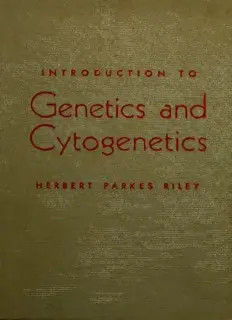
Introduction to genetics and cytogenetics PDF
Preview Introduction to genetics and cytogenetics
N T R O D U C T I eneti n o ERSERT PARKES RtlE B3 £ I Marine Biological Laboratory Library I I Woods Hole, Mass. I I I ,^='^^^\j I I I Presented by I I ESTATE OF HARRY L. WEIMAN I Octcberp 1964 I I I I I J^^^^^^^^^^^^^St w iJ.f INTRODUCTION TO GENETICS AND CYTOGENETICS INTRODUCTION O T Genetics and Cytogenetics BY HERBERT PARKES RILEY Head, Department of Botany University of Ker^tucky ^^M^AC^ JOHN WILEY SONS, NEW YORK & INC., CHAPMAN LONDON & HALL, LIMITED, PREFACE In this book I have endeavored to state and to explain the basic principles of biological inheritance and to show the impor- tance of those principles to man, to the improvement of plants and animals, and to organic evolution. I have attempted to pre- sent this material in a simple fashion so that any reader can grasp the fundamentals of heredity in spite of limited biological training. However, I have also included some of the data that support these principles so that the student who wishes can ac- quire an adequate background for further studies in heredity, and I have added a fairly extensive bibliography so that the more serious student will have a diversified list of some of the items of the research literature should he wish more information on a subject than a book of this size can offer. Throughout this book I have stressed general principles rather than practical applications and have drawn my illustrations from both the Plant and the Animal Kingdoms. For the reader who is interested in human biology, references to inherited traits are numerous, and Chapters 3 and 19 should be of especial im- portance. The emphasis on principles and the variety of the illustrations should make this book of value to students of agri- culture, psychology, and sociology. It should serve also as a foundation for advanced work in genetics and cytogenetics. The book is readily divisible into four parts. The first five chapters provide a survey of general biological information which must be understood before progressing into the field of genetics itself. In Chapters 6 through 13 I discuss the funda- mental principles of the transmission of genes. In discussing the method by which genes are distributed from generation to generation, I have used the cytological approach, describing chromosomes and their behavior at cell division and reproduc- tion. Chapters 14 through 23 make up the third part of the book. They deal with the nature and physiology of genes and also include some topics of practical and of general interest. vii viii Preface Chapters 24 through 30, the fourth and last part of the book, deal with what are frequently called "chromosomal aberrations." If we accept an ideal concept of chromosomal behavior during cell division and reproduction and if we accept the 2n number as the ideal number of chromosomes in the animal soma or in the plant sporophyte and the n number as ideal in the plant gametophyte, any departure from these ideal conditions repre- sents an aberration. The various types of aberrations are de- scribed in this section, and their bearing on problems of evolution is discussed. This material is often called "cytogenetics," al- though any correlation at all between genetic data and cytologi- cal observations should properly bear this designation. Throughout I have tried to avoid being dogmatic on all or most controversial issues. Sometimes I have attempted to pre- sent all the important theories concerned in the explanation of certain data without expressing any preference, and on some points where I have favored one theory I have presented other theories for the student to consider. Because of its scope, I have had to restrict the bibliography somewhat. Many important papers have had to be omitted en- tirely and where an author had published a series of papers on the same subject, I have listed only a few. Although I did not adhere rigidly to any rule, I frequently listed the first paper of the series and the most recent. I usually, also, included papers that contained extensive bibliographies or summarized informa- tion and those that were especially outstanding for the theories or conclusions that they presented. Even though a paper was referred to in more than one chapter, I included it in the bibli- ography only once. Several persons have read all or part of the manuscript, and to them I wish to express my deepest appreciation. However, I must emphasize that they are in no way responsible for any of the errors that may appear in the book. Professor George H. Shull of Princeton University has read and criticized the en- tire text in manuscript, and I am very grateful to him for many suggestions. I also wish to thank Professor P. W. Whiting of the University of Pennsylvania for his kindness in reading and criticizing the manuscript of parts of Chapters 16 and 29. Doctor Alexander Wiener of Brooklyn, New York, read the manuscript of most of Chapter 19 and made many suggestions
